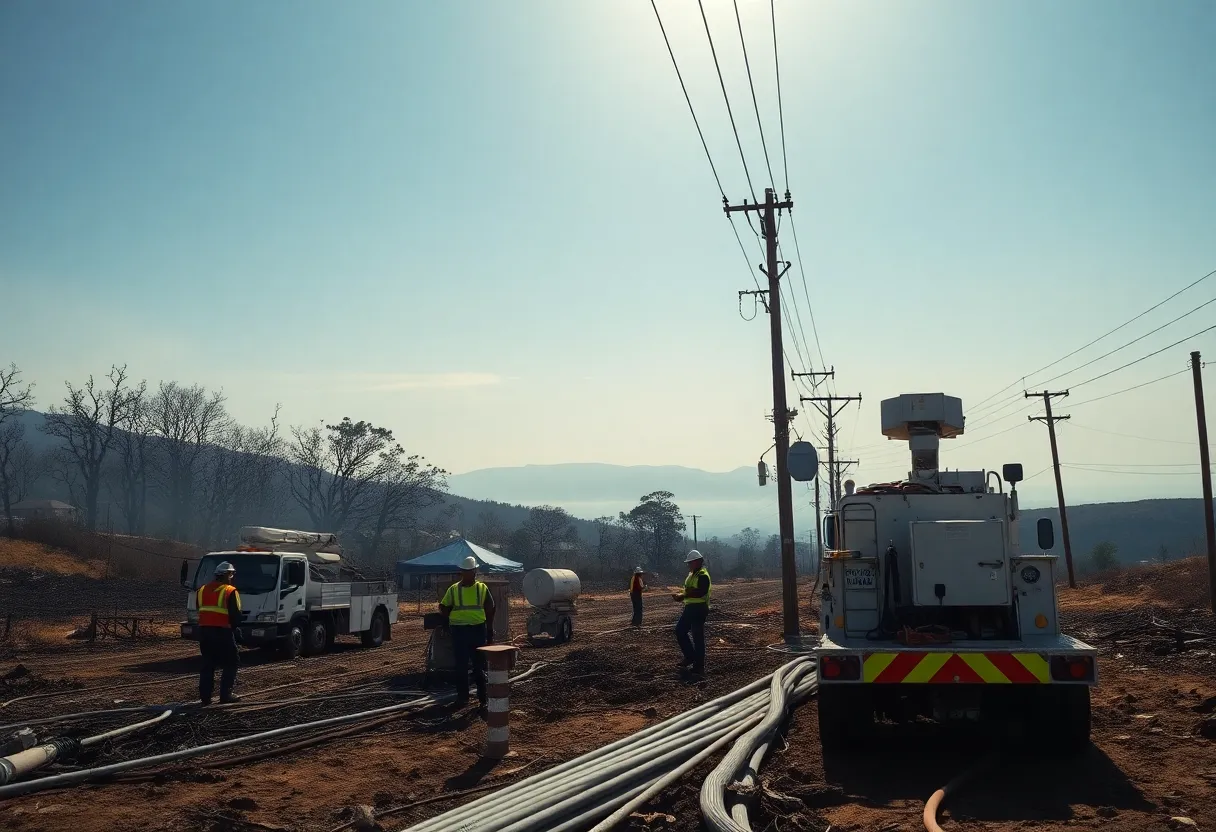California (Eaton and Palisades fire zones), August 16, 2025
News Summary
The governor issued an executive order temporarily suspending state-level CEQA and California Coastal Act reviews for utility work restoring electric, gas, water, sewer and telecommunications infrastructure in the Eaton and Palisades fire zones. The move aims to shorten permitting and environmental review timelines to accelerate utility restoration and encourage undergrounding where feasible. Officials say the order complements earlier waivers, but rebuilding still faces major challenges including skilled labor shortages, materials and transformer supply limits, high construction lending costs, insurance barriers, and local permitting delays. Environmental groups call for balanced safeguards as recovery proceeds.
California waives environmental reviews for utility rebuilding after major L.A. fires; experts warn of steep hurdles ahead
State officials have moved to speed rebuilding in areas hit by recent Los Angeles firestorms by temporarily suspending two major environmental laws for utility work. The action clears many permitting and review steps for companies reinstalling electric, gas, water, sewer and telecommunication infrastructure in the Palisades and Eaton burn zones, and encourages putting key equipment underground where feasible. At the same time, housing and construction experts say the real bottlenecks are likely to be shortages of skilled workers, scarce building materials, and high lending and insurance costs.
What changed at the state level
The governor issued an order that removes the need for compliance with the California Environmental Quality Act (CEQA) and the California Coastal Act for most utility reconstruction in impacted zones. The move builds on earlier orders that eased reviews for rebuilding homes, businesses and wildfire prevention work. Officials say the waivers are meant to get utility systems back quickly and help people return home faster.
Immediate focus and limits
For now, emergency cleanup and housing for tens of thousands of displaced residents remain the top priorities while the fires approach full containment. The state also set an April 15 deadline for property owners to sign up for debris removal through a federal cleanup program, which now includes some multifamily buildings.
Why officials are pushing undergrounding
Undergrounding distribution lines is being promoted as a way to reduce future wildfire risk. Some work to move wires below ground had already been planned or permitted before the latest action, including substantial mileage planned in Altadena and the Palisades. But installing utilities underground is significantly more expensive than above-ground work, and the new order mainly speeds permits rather than covering added costs.
Big hurdles to rebuilding housing and infrastructure
Even with faster permits, experts warn that rebuilding will not happen fast or cheaply. The construction industry faces a long-running shortfall of skilled tradespeople. A national building-industry group noted that lending rates for builders remain high, around the low double digits for many projects, which raises the cost of construction loans. Materials are another worry: some prices like lumber fell after pandemic peaks, but possible new tariffs and a surge in demand could push them up again. Specialized parts such as electrical transformers are already scarce in many markets.
Insurance, mortgages and financial strain
Homeowners and builders also face insurance and financing hurdles. Some insurers have pulled back from high-risk areas, leaving affected homeowners with limited, expensive coverage options that can make mortgages hard to get. After large-loss wildfire events, the state-backed insurer of last resort required an emergency assessment from participating insurance companies, which is likely to raise premiums for many property owners.
How quickly homes may return
Historical analysis indicates that new construction tends to bounce back fairly quickly after California fires, but many homeowners choose not to rebuild. Developers may make purchase offers on damaged lots that can be higher than insurance payouts, and land values in coastal and hillside neighborhoods make redevelopment attractive. Still, permit pipelines are clogged: hundreds of homeowners have applied for rebuild permits while approvals lag, and local processing averages weeks to months.
Environmental and community concerns
The two laws that were suspended were created to identify and limit harm to water, wildlife, air and climate. Environmental groups say that emergency speed should be balanced with long-term protections, urging careful testing and planning rather than blanket waivers. State officials say the actions are limited to rebuilding and resilience work and do not signal a broader rollback of environmental rules.
Workforce and training efforts
To help address the labor gap, a philanthropic foundation announced a half-million-dollar investment in trades training for the region, supporting postsecondary pathways to skilled work. The construction industry faces hundreds of thousands of open trades jobs nationwide, and a large share of current workers are expected to retire in the coming decade. Training programs aim both to speed recovery and build longer-term capacity.
Background: scale of the disaster
The winter and spring fires burned nearly 48,000 acres and damaged or destroyed more than 16,000 structures. That includes thousands of single-family homes, dozens of duplexes and hundreds of apartments—compounding housing shortages in an already tight market.
What to watch next
- Permit approvals: whether local permitting speeds up and how many rebuild permits actually clear review.
- Material and labor prices: shifts in lumber, transformers and other supplies, and effects of any new tariffs.
- Insurance availability: whether insurers return to the market or premiums keep rising.
- Undergrounding plans: how much work gets completed and how costs are managed.
FAQ
Will suspending CEQA and the Coastal Act let utilities rebuild faster?
The waivers remove certain environmental reviews and permitting steps that often slow projects, so utilities can move more quickly on some installations and undergrounding work. However, the order mainly speeds approvals and does not directly solve labor, material or financing shortages.
Does this change allow homes to be rebuilt more quickly?
Prior executive actions already eased some rebuilding rules for homes and businesses. While fewer reviews can speed parts of the process, local permit backlogs, building code updates, high costs and insurance issues still slow many homeowners from rebuilding right away.
Is undergrounding utilities guaranteed after this order?
The state encourages undergrounding and has pushed the main electricity provider to use opportunities to move lines below ground. But underground work is costly and will be done where feasible and permitted; the order mainly helps reduce permitting hurdles for those projects.
What are the biggest obstacles to fast recovery?
Experts point to three main constraints: a shortage of trained tradespeople, rising or volatile prices for key materials and equipment, and high interest or construction loan rates together with insurance challenges that affect home replacement and lending.
Are environmental protections gone for good?
The order applies to rebuilding in specific fire zones and to certain categories of utility work. Officials say it is an emergency step, not a permanent change to statewide environmental policy. Environmental advocates remain concerned and are calling for careful checks and balances as rebuilding proceeds.
Key features at a glance
| Feature | What it means | Near-term impact |
|---|---|---|
| Environmental waivers | Suspends CEQA and Coastal Act reviews for specific utility rebuilds | Faster permitting for utility companies; does not remove all obstacles |
| Encouraged undergrounding | Priority to bury lines to reduce fire risk | More resilient systems but higher construction costs |
| Labor shortage | Not enough skilled tradespeople in the region | Slower rebuilding; new training programs aim to help |
| Material and equipment risks | Lumber, transformers and other materials may be limited or price-volatile | Costs could rise if demand spikes or tariffs change |
| Insurance and financing | High premiums and limited coverage reduce mortgage and rebuild options | Many homeowners face higher costs or choose not to rebuild |
| Scale of damage | Tens of thousands displaced; nearly 48,000 acres burned and over 16,000 structures lost or damaged | Major test for housing supply and emergency response systems |
Deeper Dive: News & Info About This Topic
Additional Resources
- NBC Los Angeles: How Paradise is Being Rebuilt — What SoCal Can Learn Post-Fires
- Wikipedia: Wildfire
- Holland & Knight: Orders Addressing Rebuilding After Southern California Fires
- Google Search: Southern California rebuilding after fires
- CBS News: Southern California faces frustrating, expensive rebuilding process
- Google Scholar: rebuilding after wildfires California
- Los Angeles Times: California suspends environmental laws to speed rebuilding, undergrounding utilities
- Encyclopedia Britannica: California Environmental Quality Act
- Wired: Why it’s taking LA so long to rebuild after the wildfires
- Google News: LA rebuild after wildfires
Author: Construction CA News
The CALIFORNIA STAFF WRITER represents the experienced team at constructioncanews.com, your go-to source for actionable local news and information in California and beyond. Specializing in "news you can use," we cover essential topics like product reviews for personal and business needs, local business directories, politics, real estate trends, neighborhood insights, and state news affecting the area—with deep expertise drawn from years of dedicated reporting and strong community input, including local press releases and business updates. We deliver top reporting on high-value events such as the Rose Parade, Coachella, Comic-Con, and the California State Fair. Our coverage extends to key organizations like the California Building Industry Association and Associated General Contractors of California, plus leading businesses in technology and entertainment that power the local economy such as Apple and Alphabet. As part of the broader network, including constructionnynews.com, constructiontxnews.com, and constructionflnews.com, we provide comprehensive, credible insights into the dynamic landscape across multiple states.




